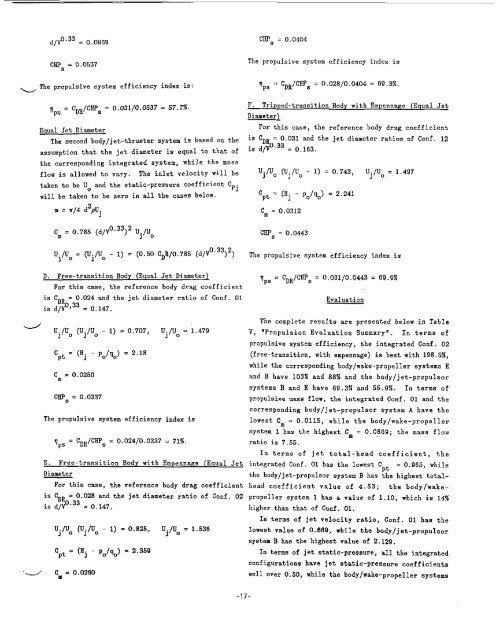Fuselage self-propulsion by static-pressure thrust - CAFE Foundation
Fuselage self-propulsion by static-pressure thrust - CAFE Foundation
Fuselage self-propulsion by static-pressure thrust - CAFE Foundation
Create successful ePaper yourself
Turn your PDF publications into a flip-book with our unique Google optimized e-Paper software.
d/V0'33 = 0.0969<br />
CHPs = 0.0404<br />
CUP = 0.0537 The propulsive system efficiency index is<br />
S<br />
-The propulsive system efficiency index is:<br />
7PS<br />
= CDR/CBps = 0.031/0.0537 = 57.7%.<br />
VPS = CDR/CHPs = 0.028/0.0404 = 69.3%.<br />
F. Tripped-transition Body with EmpennaRe (Equal Jet<br />
Diameter1<br />
Equal Jet Diameter<br />
The second body/jet-<strong>thrust</strong>er system is based on the<br />
For this case, the reference body drag coefficient<br />
is CDR = 0.031 and the jet diameter ratios of Conf. 12<br />
assumption that the jet diameter is equal to that of is d/V0'33 = 0.163.<br />
the Corresponding integrated system, while the mass<br />
flow is allowed to vary. The inlet velocity will be<br />
uj/"o (uj/Uo - 1) = 0.743,<br />
taken to be Uo and the <strong>static</strong>-<strong>pressure</strong> coefficient C<br />
'j<br />
will be taken to be Zero in all the cases below. c = (Ej - p,/g)<br />
Pt<br />
= 2.241<br />
2<br />
m = %/4 d pU.<br />
3<br />
Cm = 0.0312<br />
C m = 0.785 (d/V0'33)2 U./U 1 0<br />
U./U I O = (U./U I O<br />
0.33) 2)<br />
- 1) = (0.50 CDR/0.785 (d/V<br />
D. Free-transition Body (Equal Jet Diameter1<br />
For this case, the reference body drag coefficient<br />
is CDR = 0.024 and the jet diameter ratio of Conf. 01<br />
is d/V0833 = 0.147.<br />
U./U (U./U - 1) = 0.707, U./U = 1.479<br />
1 0 J O J O<br />
C = (E. - p /q ) = 2.18<br />
Pt I 0 0<br />
Cm = 0.0250<br />
CBPs = 0.0337<br />
The propulsive system efficiency index is<br />
CBps = 0.0443<br />
Uj/Uo = 1.497<br />
The propulsive system efficiency index is<br />
"p"<br />
= CDR/CBps = 0.031/0.0443 = 69.9%<br />
Evaluation<br />
The complete results are presented below in Table<br />
V, 'Propulsion Evaluation Summary". In terms of<br />
propulsive system efficiency, the integrated Conf. 02<br />
(free-transition, with empennage) is best with 198.5%,<br />
while the corresponding body/wake-propeller systems E<br />
and B have 103% and 88% and the bodyljet-propulsor<br />
systems B and E have 69.3% and 55.QX. In terms of<br />
propulsive mass flow, the integrated Conf. 01 and the<br />
corresponding body/jet-propulsor system A have the<br />
lowest C = 0.0115,<br />
m<br />
while the body/wake-propeller<br />
system 1 has the highest Cm = 0.0889; the mass flow<br />
= CDR/CBps = 0.024/0.0337 = 71%.<br />
ratio is 7.55.<br />
7PS<br />
In terms of jet total-head coefficient, the<br />
E. Free-transition Body with Empennage (Equal Jet integrated Conf. 01 has the lowest C = 0.965, while<br />
Pt<br />
Diameter<br />
the body/jet-propulsor system B has the highest total-<br />
For this case, the reference body drag coefficient head coefficient value of 4.53; the bodyrwakeis<br />
CDR = 0.028 and the jet diameter ratio of Conf. 02 propeller system 1 has a value of 1.10, which is 14%<br />
is d/V0'33 = 0.147. higher than that of Conf. 01.<br />
In terms of jet velocity ratio, Conf. 01 has the<br />
Ui/uo (Uj/Uo - 1) = 0.825, Ui/Uo = 1.536<br />
lowest value of 0.669, while the body/jet-propulsor<br />
system B has the highest value of 2.128.<br />
= (Ej - po/g) = 2.358<br />
In terms of jet <strong>static</strong>-<strong>pressure</strong>, all the integrated<br />
CPt<br />
'd Cm = 0.0260<br />
-17-<br />
configurations have jet <strong>static</strong>-<strong>pressure</strong> coefficients<br />
well over 0.50, while the body/wake-propeller systems

















